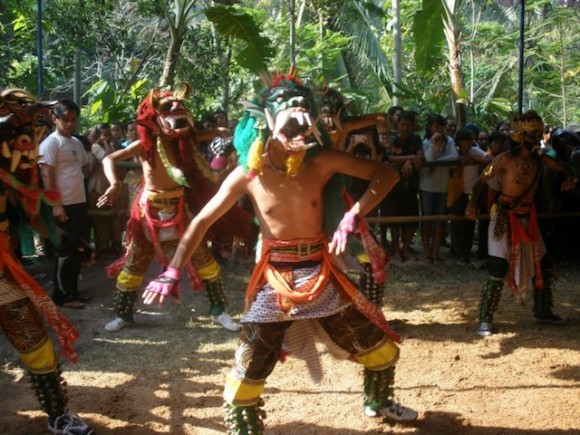“Mister! Mister!”
Children run barefoot along the dusty gravel behind my motorcycle, chanting the words like they’re some kind of ritual welcome.
I can’t help but smile as I pass by. It always amuses me that gender gets lost in translation.
Perhaps if more Australians could experience moments like this then they too would understand the zeal that comes from being able to speak Indonesian.
For many years now rates of enrolment in Indonesian language studies have been declining across Australia. Declining is an understatement. At the current rate, Indonesian is a language that will be near extinct in Australian high schools as soon as 2020.
Despite its best efforts the Abbott Government, much like its predecessors, is yet to broker serious change on this issue.
Enrolment rates continue to fall despite expert warnings that Indonesia’s economy will continue to grow at unanticipated rates over the coming decades. They continue to fall despite programs such as the New Colombo Plan, offering scholarships to students who wish to study in the Indo-Pacific region.
And they continue to fall despite the launch of the Australia Indonesia Centre (AIC) last year, a joint initiative of both governments to give students more opportunities to build and embrace cross-cultural ties.
Dr Leonie Lethbridge, a Board Member of the AIC and Regional Chief Operating Officer of ANZ Bank, has witnessed how Australian perceptions of Indonesia as a nation continue to have a peculiar impact on the study of Bahasa Indonesia.
“Indonesia tends to be defined as a reflection of the current state of the bilateral relationship and as a caricature of a large Muslim population, rather than on the place and importance of the nation and culture,” Dr Lethbridge says.
An expat who has lived in Asia for more than a decade, she argues that “urgent intervention is required to arrest the decline in study” of Indonesian in Australia.
Dr Lethbridge identifies several areas where interventions could be made, such as making language studies a mandatory core of the secondary curriculum Australia-wide. This, she believes, would “ensure a strong pipeline of language students”.
As someone who learned Bahasa Indonesia from native speakers, Dr Lethbridge is also an advocate for a stronger supply of language teachers who speak Indonesian as their first language. Despite all this, she still recognises the need for Indonesia to alter its perception internationally to promote the relevance of the language, the nation and the culture.
“In recent years, Indonesia has invested to highlight its development, its economic credentials and its place as a rising middle power,” she says. “However, there are still misperceptions about instability… it’s not always clear what Indonesia uniquely stands for. Ongoing investing in re-branding will be important for Indonesia, and will have benefits for study of the language.”
This is well founded advice, given that a 2012 report by the Australian Department of Foreign Affairs and Trade revealed that less than half of all Australians understand Indonesia is a democracy, and a majority wrongly believe that law-making is based on Islamic codes.
Perhaps these cultural illiteracies are lost in translation, the result of a shrinking pool of linguistic and cultural experts.
Adding to this, the recently released 2014 Lowy Institute Poll shows that three-quarters of the Australian population identify “security in the region”, “terrorism” and “asylum seekers and people smuggling” as the three most important issues for Australia-Indonesia relations.
But by far the most telling reflection on the current state of Australia-Indonesia relations was the title in this latest Lowy report: Relations with Indonesia: deteriorating but friendly.
In times such as these, organisations like the Australia Indonesia Youth Association (AIYA) are coming to play a more integral role in bridging gaps by connecting, informing and inspiring the younger generation. The President of AIYA’s ACT chapter, Kirrilly McKenzie, has seen first-hand how deteriorating relations with Indonesia have impacted on language enrolments in Australia.
“Every time there’s a huge event like the bombings or something political the rates decline again,” she says with subdued frustration. “We need more teachers that are true Indonesianists.”
The university student elaborates on this point with a story about a language teacher travelling with her to Java last year on cultural exchange.
“He was there on a scholarship from the Australian Government to learn Indonesian to teach to his school,” she recalls. “He wasn’t very passionate about Indonesia until he went over there. He learned the real value of Indonesian, of teaching Indonesian in schools.”
Kirrilly is much more than an advocate for quality Indonesian education in Australian schools: she is the product of it. She speaks with such enthusiasm for her “extremely passionate” high school teachers who sparked her lust for the language almost a decade ago.
And she remains resilient for a language that she knows is plagued with uncertainty and unpopularity among her peers.
Indonesian has now become so unfashionable that a report published in 2010 on the current state of Asian language education in Australia’s schools named Indonesian as “at risk” with less than 1 per cent of the total cohort of senior secondary students choosing to study it.
And yet, in his address to the Australian Parliament in 2010, Indonesian President Susilo Bambang Yudhoyono said that there was “no other Western country where Bahasa Indonesia is widely taught in the school curriculum” and “no other Western country with more Indonesianists”.
Observations like these make our Indonesian language figures look increasingly like a joke or a statistical error.
Caught on the other side of this increasing divide are those passionate few like Australian National University (ANU) student Fay Edwards. A student of Asia-Pacific Studies currently living in Yogyakarta, Fay says that dwindling language enrolments reflect lax efforts to engage with Indonesia at a grassroots level.
“Tourism from Australia to Indonesia still heavily focuses on Bali,” she notes. “The refugee issue demonstrates that Australia still believes it can bulldoze its way through the relationship without making any concessions.”
Broader political concerns aside, Fay floats the idea that Indonesia is not seen as a ‘cool’ country. She thinks that people are more drawn to languages that appear to present more options for employment and financial gain, such as Chinese.
Bahasa Indonesia is by no means a sexy language either. It has none of the flair of French. Nor the pizzazz of Italian. But it does offer the ability to be among the networked cohort of Australia’s Indonesianists, increased employability and opportunities for travel, to name a few.
Sadly, as Fay points out: “Australia has not yet realised that Indonesia is an equal partner, not a poor neighbour to be exploited.”
Sensing her disappointed tone I decide to wrap things up on a lighter note.
“Tell me something funny about your experience of Indonesia,” I venture.
She pauses a moment to collect her thoughts. A smile creeps across her face, evidence that I have struck a cord.
“I get called mister a lot!”





